

Did you know that up to 70 million people in the United States suffer from digestive disease? And many more deal with frustrating digestive issues with no seemingly good answer as to why. This is where the low FODMAP diet may play a role in helping to reduce symptoms. However, there can be some serious negative effects to your gut microbiome if it is used for too long. Let’s dive in!
While many different diet options exist – the Mediterranean diet, paleo diet, or the keto diet – the low FODMAP diet is not a traditional diet used to trim up and eat healthy. It’s used temporarily to get to the root of frustrating gastrointestinal symptoms.
What Is a Low FODMAP Diet?
It’s a temporary, restrictive diet plan often used to find out what foods may be causing unwanted gastrointestinal symptoms, like diarrhea, constipation, gas or bloating. Because food is often a precipitating factor of gastrointestinal symptoms, a restrictive diet like the low FODMAP diet helps identify what is causing trouble.
Who Might Benefit from a Low FODMAP Diet?
People with conditions like irritable bowel syndrome (IBS); irritable bowel diseases (IBD) like Crohn’s, celiac disease, or ulcerative colitis; small intestinal bacterial overgrowth (SIBO); and intestinal methanogenic overgrowth (IMO) may all benefit from a low FODMAP diet, especially when used after antimicrobial treatment to control the overgrowths.
- Irritable bowel syndrome (IBS) is a chronic condition in the gastrointestinal tract affecting up to 15% of the general population. IBS is associated with altered bowel habits and chronic abdominal pain. Often those with IBS have normal test results and no clinical signs of a disease but struggle with frustrating chronic gastrointestinal symptoms. One study showed that after six weeks of a low-FODMAP diet, participants had significantly less severe gastrointestinal symptoms in comparison to the control group who ate their normal diet.
- Irritable bowel disease (IBD) is a group of gastrointestinal disorders associated with inflammation in the digestive tract. The main conditions included in irritable bowel disease include Crohn’s disease, ulcerative colitis, and celiac disease. While there’s no cure for these conditions, they have been traditionally managed with medications. But eating a low FODMAP diet for a short period of time can help identify troublesome foods that may be contributing to frustrating symptoms.
- Small intestinal bacterial overgrowth (SIBO) is exactly what it sounds like – an abnormal overgrowth of bacteria in the small intestine. The bacteria eat sugars and carbohydrate rich compounds from the food you eat and then ferment them into gas. The overgrowth of bacteria releases the gas into the small intestine, which can cause digestive symptoms like bloating, cramping, diarrhea, and indigestion. Testing for SIBO is often done with a breath test called the Trio-Smart test by Gemelli Biotech. This is the most up to date and comprehensive breath test.
- Intestinal methanogenic overgrowth (IMO) is another overgrowth of bacteria in the small intestine, but these bacteria specifically release methane gas when they ferment the foods you eat. Symptoms can range from mild to severe and include gas, bloating, cramping, indigestion, and constipation. Interestingly, up to 8% of those with IBS actually have IMO or SIBO.
What are FODMAPs?
FODMAPs are short-chain carbohydrates often poorly absorbed in the small intestine. They can be hard for many people to digest because the bacteria in the gut ferment them.
FODMAP stands for: fermentable, oligosaccharides, disaccharides, monosaccharides and polyols. Let’s take a closer look at what each of these terms actually means to get a better idea.
Fermentable: These are foods that your gut bacteria love and feed on, which converts them to gas in a process called fermentation. Fermentable foods include pickled foods, yogurt, kefir, and sauerkraut.
Oligosaccharides: Soluble plant fibers known as prebiotics, oligosaccharides feed beneficial gut bacteria and include foods like garlic, onions, beans, lentils, and many wheat products.
Disaccharides: Lactose is the main fermentable sugar found in the disaccharide group. Foods high in disaccharides include dairy products.
Monosaccharides: Fructose, or fruit sugar, is the fermentable sugar targeted in this group. Not all fruits have the same quantity of fructose, so certain quantities and proportions vary. Foods high in monosaccharides include mangos, apples, and snap peas.
Polyols: Known as sugar alcohols, polyols are often used as artificial sweeteners but can also occur naturally in some fruits like blackberries, peaches, plums, and cherries.
Digestive Symptoms from Eating High FODMAPs Foods
Because they’re poorly absorbed in the small intestine, they can be difficult for some people to digest, causing uncomfortable symptoms after eating like:
- Gas
- Cramping
- Bloating
- Diarrhea
- Constipation
How Does the Low FODMAP Diet Work?
The low FODMAP diet is a temporary way of eating, helping to identify where uncomfortable digestive symptoms may be coming from. It’s important to note that it’s temporary, not a long term way of eating because it’s a diet low in foods that feed our healthy gut microbiome.
The low FODMAP diet consists of three stages: elimination, reintroduction, and personalization.
Elimination
In this first phase, you eliminate all high-FODMAP foods for several weeks. Normally, you’ll be in the elimination phase between 30 and 60 days, since it can take this long for your body to adjust and the symptoms to subside. For some, their symptoms will resolve very fast, but for others, symptoms begin to improve after several weeks. There are MANY different lists and apps out there that can help you determine if a food is high or low in FODMAPs and can even get super specific with serving sizes on certain food items as well. A great example is Monash University’s FODMAP diet app. Your specific version of eliminations will also depend on if you have other dietary needs, allergies, sensitivities, or intolerances to consider.
Examples of High FODMAP foods to avoid include:
- Dairy-based milk products
- Wheat-based products like bread and crackers
- Beans and lentils
- Certain vegetables like asparagus, onions and garlic
- Stone fruits like cherries, pears and peaches
Examples of Low FODMAP foods to include during the elimination phase include:
- Grains like quinoa, oats, and rice
- Almond milk
- Fruits like oranges, strawberries, grapes, and blueberries
- Eggs and meat
- Vegetables like potatoes, cucumbers, zucchini, and tomatoes
Reintroduction
After following the low FODMAP diet guidelines in the elimination phase, the reintroduction of certain foods begins. While still eating primarily low FODMAP foods, you’ll re-introduce one new high FODMAP food at a time every three to four days to see how the gut responds. Does that food cause symptoms like gas, bloating, diarrhea or constipation? This is when you’ll notice which foods you can tolerate and in what amounts.
Personalization
This is the final phase of the FODMAP diet, where you modify your diet to increase the variety of nutrients and foods you’re eating. You’ll also adjust the type and amount of FODMAP carbs your body can handle based on what you learned in the reintroduction phase. This is best done with a professional like a functional medicine provider or a dietician to help you find a way of eating that is sustainable and works for you and your body.
The Low FODMAP Diet and Functional Medicine
You deserve freedom from your digestive issues, those frustrating symptoms you just can’t seem to kick no matter what you try. This is when a low FODMAP diet may be the right next step for you.
At Arizona Wellness Medicine, we work with you to get to the bottom of your digestive issues. We know how debilitating it can be to deal with chronic symptoms that just don’t seem to go away. That’s why each of our functional medicine providers are experienced in getting to the root of your symptoms, using high quality testing, and techniques like a low FODMAP diet in conjunction with a personalized treatment plan to help you find relief of your symptoms. Learn more about how functional medicine can help you at Arizona Wellness Medicine here.
Resources:
Share:
Dr. Emily Parke
Social Media
Most Popular Posts
Subscribe To Our Newsletter
Related Posts

New Podcast Episode: My journey into functional medicine + what I’ve learned
I’m excited to share that I recently joined DeLo for Episode 165 of the On the DeLo podcast! In this conversation, we explored my journey

Understanding the Essential Labs for Women on Hormone Replacement Therapy (HRT)
So what are the minimum labs we’re looking at when we do hormone replacement therapy? We obviously want to look at an estrogen level, so

How to figure out the right amount of HRT in women
What about checking lab values when you’re on hormone replacement therapy? I do find it to be helpful, but we also want to consider symptoms.

Did you know there’s a difference between food allergies, sensitivities, and intolerances?
Did you know that there’s a difference between food allergies, food sensitivities and food intolerances? Food allergies, the reactions tend to happen pretty immediately and
